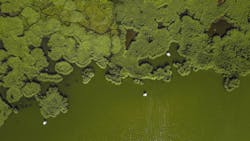EPA tools to help reduce nutrients in water, improve public health and support ecosystems
WASHINGTON -- As part of Water Week 2021, the U.S. Environmental Protection Agency (EPA) released new tools and information that states, territories, and authorized Tribes can use to help protect people, animals, and aquatic life from harmful algal blooms and other adverse effects of nutrients in water.
“These actions underscore EPA’s commitment to science and achieving shared goals through strong partnerships with states, Tribes, and local leaders,” said EPA’s Principal Deputy Assistant Administrator for Water Radhika Fox. “Nutrients in water represent a multifaceted challenge—underscoring the necessity of holistic, ‘one water’ strategies to make sustainable progress.”
N-STEPS Online EPA’s Nutrient Scientific Technical Exchange Partnership & Support (N-STEPS) program released a new web-based resource, N-STEPS Online, that provides technical assistance to states, territories, and authorized Tribes to help water quality scientists and managers derive numeric nutrient criteria. N-STEPS Online contains technical support documents, case studies, tools, and data sources. Through a User-Centered Design approach, N-STEPS Online better communicates the latest scientific information and technical approaches to EPA’s partners. This resource includes information from existing EPA guidance, as well as examples from state and tribal numeric nutrient criteria development experiences. N-STEPS Online was developed through a multi-year process of collaboration with state and tribal stakeholders. EPA looks forward to continuing this collaboration as science and technology advance to ensure that N-STEPS Online continues to provide the latest information and tools.
User Perception Surveys Primer EPA has also published a new resource to help states and Tribes develop scientific surveys to better protect aesthetic and recreational waterbody uses. Titled, Development of User Perception Surveys to Protect Water Quality from Nutrient Pollution: A Primer on Common Practices and Insights, states and Tribes can use this information to develop numeric nutrient criteria to adopt into their water quality standards under the Clean Water Act. The primer draws from previously conducted state user perception surveys, peer reviewed literature, and interviews with state and federal water quality professionals experienced with conducting user perception surveys. Other states, territories, and authorized Tribes can consider best practices to inform their survey design, implementation, and analysis. EPA remains committed to partnering with states, territories, and authorized Tribes to continue to track progress towards the adoption of numeric nutrient criteria into water quality standards.
Hypoxia Task Force Newsletter EPA believes that strong collaboration with key stakeholders is essential to reducing nutrients in our nation’s waters. The agency, which co-chairs the Hypoxia Task Force with the Iowa Department of Agriculture, plays an active role in supporting best practices for nutrient reduction across federal, state, and tribal members to decrease the hypoxic zone in the Gulf of Mexico. Today, EPA released the latest issue of the Hypoxia Task Force quarterly newsletter, highlighting ongoing collaborative efforts within the twelve member states to reduce nutrients in the Mississippi/Atchafalaya River Basin.
